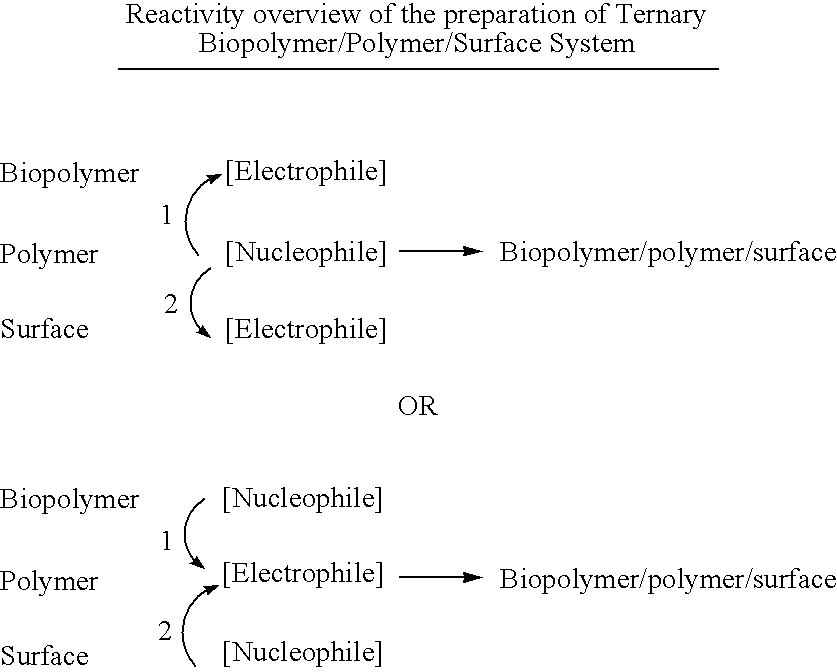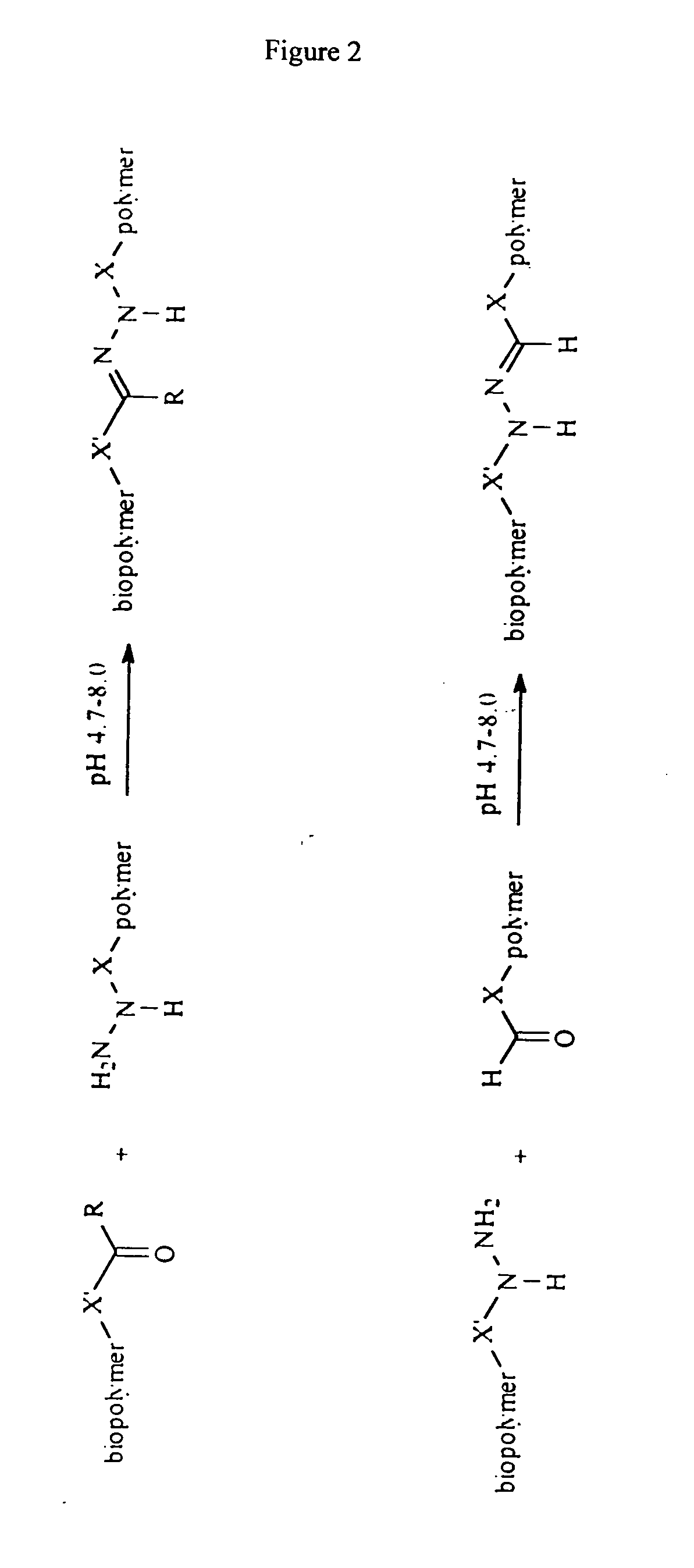Biomolecule/polymer conjugates
a polymer and polymer technology, applied in the field of biomolecule/polymer conjugates, can solve the problems of poor yield of full length products, inability to produce oligonucleotides longer than 20-25 mers, and inefficient production of both protein and poly/oligonucleotide microarrays, etc., to achieve efficient immobilization, reduce the effect of oxidative stress and low cos
- Summary
- Abstract
- Description
- Claims
- Application Information
AI Technical Summary
Benefits of technology
Problems solved by technology
Method used
Image
Examples
example 1
See FIG. 4
[0132] Preparation of 5′-aldehyde modified oligonucleotides: 5′-adehyde modified oligonucleotide 5′-OHC-aryl-TTT TTT TAG CCT AAC TGGA TGC CAT G-3′ was obtained from Solulink, Inc (San Diego, Calif). The 5′-aldehyde was incorporated using Solulink's proprietary aldehyde phosphoramidite linker (Schwartz, filed Aug. 1, 2000 (Attorney Docket No. 37154-751).
[0133] Preparation of HyNic::polyethyeleneimine: A solution of polyethyleneimine (50% by weight; 1 g; Sigma Chemicals, St. Louis, Mo.) in DI water (3 mL) was prepared and the pH lowered to 7.4 with concentrated hydrochloric acid (1.5 mL). 10× Conjugation buffer (1 M phosphate, 1.5 M NaCl, pH 7.4;:0.45 mL) was added. A solution of SANH (27.4 mg) was dissolved in DMF (200 uL). Four 1.0 mL aliquots were treated with SANH / DMF solution (0, 17.5, 35.0 and 52.5 uL) respectively. On addition the reaction mixtures became cloudy and were allowed to stand at room temperature for 2 hours. The reaction mixtures were centrifuged to remov...
example 2
[0156] SFB modification of poly-l-lysine: Two aliquots of poly-l-lysine (MW 20,700; Sigma Chemicals, St. Louis, Mo.; 200 uL of a 10 mg / mL solution in 100 mM phosphate, 150 mM NaCl, pH 4.7) were prepared. Succinimidyl 4-formylbenzoate (SFB; 1.75 mg; 7.1×10−3 mmol) was dissolved in DMF (17.5 uL). Aliquots of the SFB / DMF solution (2.5 and 5.0 uL) were added to the poly-l-lysine solutions. The reaction mixtures were incubated at room temperature for 2 hours. The modified polymers were isolated by gel filtration using NAP-10 columns (APBiotech, Piscataway, N.J.) pre-equilibrated with 0.1 mM MES, 0.9% NaCl, pH 4.7. Fractions containing polymer were identified using the Bradford Protein Assay and combined. The amino content of the polymers was determined by TNBSA assay (trinitrobenzenesulfonic acid; Pierce Chemicals (Rockville, Ill.). The aldehyde content was determined using the 2-hydrazinopyridine assay as described in example 1 for the quantification of the aldehyde moiety on the oligon...
example 3
[0160] Preparation of amino, aldehyde or hydrazine polynucleotides with appropriate triphosphates: Two primers and template DNA in reaction buffer containing a 70 / 30 mixture of dCTP and dCTP modified to incorporate a aromatic aldehyde group on the 5-position is added to dGTP, dTTP and dATP in equimolar amounts with heat stable DNA polymerase. A PCR reaction is performed by cycling of denaturation, annealing and extension steps. PCR products are purified using spincolumn [QIAGEN] to remove small molecule impurities.
[0161] Conjugation of PCR product to polymer The PCR product incorporating the aldehyde moiety is added to a solution of poly-l-lysine / HyNic polymer and incubated at room temperature for 4 h. The solution is used directly for immobilization.
[0162] Immobilization of polynucleotide / polymer to surface: Aliquots of the polynucleotide / polymer conjugate are spotted on aldehyde-modified glass surfaces and allowed to dry. The slide is washed with 2×SCC (three times).
[0163] Hybr...
PUM
| Property | Measurement | Unit |
|---|---|---|
| volumes | aaaaa | aaaaa |
| pH | aaaaa | aaaaa |
| volume | aaaaa | aaaaa |
Abstract
Description
Claims
Application Information
 Login to View More
Login to View More - R&D Engineer
- R&D Manager
- IP Professional
- Industry Leading Data Capabilities
- Powerful AI technology
- Patent DNA Extraction
Browse by: Latest US Patents, China's latest patents, Technical Efficacy Thesaurus, Application Domain, Technology Topic, Popular Technical Reports.
© 2024 PatSnap. All rights reserved.Legal|Privacy policy|Modern Slavery Act Transparency Statement|Sitemap|About US| Contact US: help@patsnap.com










